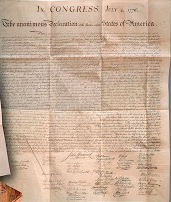 |
| |
             
| ||
| You are in: Virtual Museum of Science >> Air and Space Museum >> GEMINI VII | ||||||||||||||||||||||||||||||||||||||||||||||||||||||||||||||||||||||||||||||||||||||||||||||||||||||||||||||||||||||||||||||||||||||||||||||||||||||||||||||||||||||||||
Project Gemini Liftoff of Gemini 6A from Pad 19 with astronauts Walter Schirra and Thomas Stafford aboard (15Dec65)
Project Gemini was the second human spaceflight program of NASA, the civilian space agency of the United States government. Project Gemini operated between Projects Mercury and Apollo, with 10 manned flights occurring in 1965 and 1966. Its objective was to develop techniques for advanced space travel, notably those necessary for Project Apollo, whose objective was to land humans on the Moon. Gemini missions included the first American spacewalks, and new orbital maneuvers including rendezvous and docking.After the existing Apollo program was chartered by President John F. Kennedy on May 25, 1961 to land men on the moon, it became evident to NASA officials that a follow-on to the Mercury program was required to develop certain spaceflight capabilities in support of Apollo. Originally introduced on December 7 as Mercury Mark II, it was re-christened Project Gemini on January 3, 1962. The major objectives were: 1. To demonstrate endurance of humans and equipment to spaceflight for extended periods, at least eight days required for a moon landing, to a maximum of two weeks. 2. To effect rendezvous and docking with another vehicle, and to maneuver the combined spacecraft using the propulsion system of the target vehicle. 3. To demonstrate Extra-Vehicular Activity (EVA), or space-"walks" outside the protection of the spacecraft, and to evaluate the astronauts' ability to perform tasks there. 4. To perfect techniques of atmospheric reentry and landing at a pre-selected location. 5. To provide the astronauts with zero-gravity and rendezvous and docking experience required for Apollo. Gemini's primary difference from Mercury was that the earlier spacecraft had all systems other than the reentry rockets situated within the capsule, to which access of nearly all was through the astronaut's hatchway. In contrast, Gemini housed power, propulsion, and life support systems in a detachable Equipment Module located behind the Reentry Module, which made it similar to the Apollo Command / Service module design. Many components in the capsule itself were reachable through their own small access doors. The original intention was for Gemini to land on solid ground instead of at sea, using a paraglider rather than a parachute, with the crew seated upright controlling the forward motion of the craft. To facilitate this, the paraglider did not attach just to the nose of the craft, but to an additional attachment point for balance near the heat shield. This cord was covered by a strip of metal which ran between the twin hatches. However, this design was ultimately dropped and parachutes were used in a conventional nose-up sea landing. Early short-duration missions had their electrical power supplied by batteries; later endurance missions used the first fuel cells in manned spacecraft. The "Gemini" designation comes from the fact that each spacecraft held two people, as "gemini" in Latin means "twins". Gemini is also the name of the third constellation of the Zodiac and its twin stars, Castor and Pollux. Unlike Mercury, which could only change its orientation in space, the Gemini spacecraft could translate in all six directions, and alter its orbit. It was designed to dock with the Agena Target Vehicle, which had its own large rocket engine which was used to perform large orbital changes. Gemini was the first American manned spacecraft to include an onboard computer, the Gemini Guidance Computer, to facilitate management and control of mission maneuvers. It was also unlike other NASA craft in that it used ejection seats, in-flight radar and an artificial horizon - devices borrowed from the aviation industry. Using ejection seats to push astronauts to safety was first employed by the Soviet Union in the Vostok craft manned by cosmonaut Yuri Gagarin. The Gemini program cost $5.4 billion.
There were 12 Gemini flights, including two unmanned flight tests. All were launched by Titan II rockets. [edit]Unmanned
[edit]Manned
From Wikipedia 4-10-2010

Start your search on GEMINI VII.
The Congressional Evolution of the United States Henry Middleton
Unauthorized Site: This site and its contents are not affiliated, connected, associated with or authorized by the individual, family, friends, or trademarked entities utilizing any part or the subject's entire name. Any official or affiliated sites that are related to this subject will be hyper linked below upon submission and Evisum, Inc. review. Copyright©
2000 by Evisum Inc.TM. All rights
reserved.
|
||||||||||||||||||||||||||||||||||||||||||||||||||||||||||||||||||||||||||||||||||||||||||||||||||||||||||||||||||||||||||||||||||||||||||||||||||||||||||||||||||||||||||
             

| | |||






